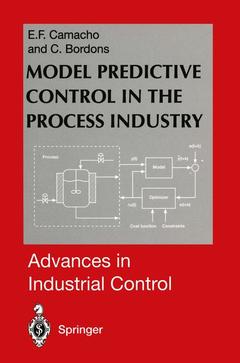Description
Model Predictive Control in the Process Industry, Softcover reprint of the original 1st ed. 1995
Advances in Industrial Control Series
Authors: Camacho Eduardo F., Bordons Carlos A.
Language: English105.49 €
In Print (Delivery period: 15 days).
Add to cart
Publication date: 11-2011
239 p. · 15.5x23.5 cm · Paperback
239 p. · 15.5x23.5 cm · Paperback
Description
/li>Contents
/li>
Model Predictive Control is an important technique used in the process control industries. It has developed considerably in the last few years, because it is the most general way of posing the process control problem in the time domain. The Model Predictive Control formulation integrates optimal control, stochastic control, control of processes with dead time, multivariable control and future references. The finite control horizon makes it possible to handle constraints and non linear processes in general which are frequently found in industry. Focusing on implementation issues for Model Predictive Controllers in industry, it fills the gap between the empirical way practitioners use control algorithms and the sometimes abstractly formulated techniques developed by researchers. The text is firmly based on material from lectures given to senior undergraduate and graduate students and articles written by the authors.
1 Introduction to Model Based Predictive Control.- 1.1 MPC Strategy.- 1.2 Historical Perspective.- 1.3 Outline of the chapters.- 2 Model Based Predictive Controllers.- 2.1 MPC Elements.- 2.1.1 Prediction Model.- 2.1.2 Objective Function.- 2.1.3 Obtaining the Control Law.- 2.2 Review of some MPC Algorithms.- 2.3 MPC Based on the Impulse Response.- 2.3.1 Process Model and Prediction.- 2.3.2 Control Law.- 2.4 Generalized Predictive Control.- 2.4.1 Formulation of Generalized Predictive Control.- 2.4.2 The Coloured Noise Case.- 2.4.3 An example.- 2.5 Constrained Receding-Horizon Predictive Control.- 2.5.1 Computation of the Control Law.- 2.5.2 Properties.- 2.6 Stable GPC.- 2.6.1 Formulation of the control law.- 2.7 Filter Polynomials for Improving Robustness.- 2.7.1 Selection of the T polynomial.- 2.7.2 Relation with other Formulations.- 3 Simple Implementation of GPC for Industrial Processes.- 3.1 Plant Model.- 3.1.1 Plant Identification: The Reaction Curve Method.- 3.2 The Dead Time Multiple of Sampling Time Case.- 3.2.1 Discrete Plant Model.- 3.2.2 Problem Formulation.- 3.2.3 Computation of the Controller Parameters.- 3.2.4 Role of the Control-Weighting Factor.- 3.2.5 Implementation Algorithm.- 3.2.6 An Implementation Example.- 3.3 The Dead Time non Multiple of the Sampling Time Case.- 3.3.1 Discrete Model of the Plant.- 3.3.2 Controller Parameters.- 3.3.3 Example.- 3.4 Integrating Processes.- 3.4.1 Derivation of the Control Law.- 3.4.2 Controller parameters.- 3.4.3 Example.- 3.5 Consideration of Ramp Setpoints.- 3.5.1 Example.- 4 Robustness Analysis in Precomputed GPC.- 4.1 Structured Uncertainties.- 4.1.1 Parametric Uncertainties.- 4.1.2 Unmodelled Dynamics.- 4.1.3 Both Types of Uncertainties.- 4.2 Stability Limits with Structured Uncertainties.- 4.2.1 Influence of Parametric Uncertainties.- 4.2.2 Influence of Unmodelled Dynamics.- 4.2.3 Combined Effect.- 4.2.4 Influence of the Control Effort.- 4.3 Unstructured Uncertainties.- 4.3.1 Process Description.- 4.3.2 Measurement of the Robustness of the GPC.- 4.3.3 Robustness Limits.- 4.4 Relationship between the two Types of Uncertainties.- 4.4.1 Uncertainty in the Gain.- 4.4.2 Uncertainty in the Delay.- 4.5 General Comments.- 5 Multivariate GPC.- 5.1 Derivation of Multivariable GPC.- 5.1.1 White Noise Case.- 5.1.2 Coloured noise case.- 5.2 Obtaining a Matrix Fraction Description.- 5.2.1 Transfer Matrix Representation.- 5.2.2 Parametric Identification.- 5.3 State Space Formulation.- 5.3.1 Matrix Fraction and State Space Equivalences.- 5.4 Dead Time Problems.- 5.5 Example: Distillation Column.- 6 Constrained MPC.- 6.1 Constraints and GPC.- 6.1.1 Illustrative Examples.- 6.2 Revision of Main Quadratic Programming Algorithms.- 6.2.1 The Active Set Methods.- 6.2.2 Feasible Directions Methods.- 6.2.3 Initial Feasible Point.- 6.2.4 Pivoting Methods.- 6.3 Constraints Handling.- 6.3.1 Slew Rate Constraints.- 6.3.2 Amplitude Constraints.- 6.3.3 Output Constraints.- 6.3.4 Constraints Reduction.- 6.4 1-norm.- 6.5 Constrained MPC and Stability.- 7 Robust MPC.- 7.1 Process Models and Uncertainties.- 7.1.1 Truncated Impulse Response Uncertainties.- 7.1.2 Matrix Fraction Description Uncertainties.- 7.1.3 Global Uncertainties.- 7.2 Objective Functions.- 7.2.1 Quadratic Norm.- 7.2.2 ? — ? norm.- 7.2.3 1-norm.- 7.3 Illustrative Examples.- 7.3.1 Bounds on the Output.- 7.3.2 Uncertainties in the Gain.- 8 Applications.- 8.1 Solar Power Plant.- 8.1.1 Control Strategy.- 8.1.2 Plant Results.- 8.2 Composition Control in an Evaporator.- 8.2.1 Description of the Process.- 8.2.2 Obtaining the Linear Model.- 8.2.3 Controller Design.- 8.2.4 Results.- 8.3 Pilot Plant.- 8.3.1 Plant Description.- 8.3.2 Plant Control.- 8.3.3 Flow Control.- 8.3.4 Temperature Control at the Exchanger Output.- 8.3.5 Temperature Control in the Tank.- 8.3.6 Level Control.- 8.3.7 Remarks.- A Revision of the Simplex method.- A.1 Equality Constraints.- A.2 Finding an Initial Solution.- A.3 Inequality Constraints.- B Model Predictive Control Simulation Program.- References.
© 2024 LAVOISIER S.A.S.





